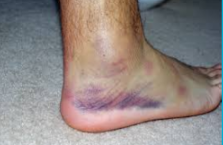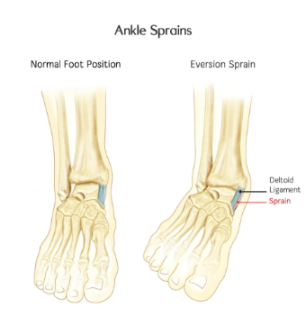
Common Injuries of the Ankle
Fracture of the Ankle/Lower Leg
Fibula Fracture: most common seen in sport activities
Talus Fracture: least common but can be mistaken as ankle sprains
Tibia Fracture: can be very serious and debilitating due to its status as the primary weight bearing bone
Fractures
MOI: Direct force against bone or indirect abuse such as twisting motion
S&S
High levels of pain
Swelling and discoloration
Obvious deformity
Inability to bear weight
Decrease strength and range of motion
Treatment:
Splint
Immobilize
Non weight bear (NWB)
Surgical interventions
Stress Fractures
Stress fx in the tibia and fibula are significant in their occurrence rates in athletics
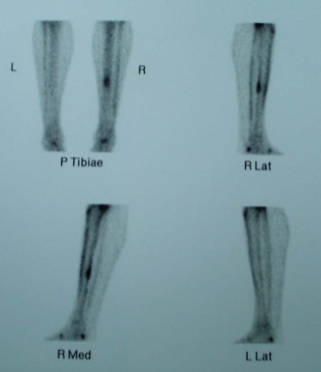
S&S
Pain that has developed gradually and increased in severity
Pain likely to be worse after activity rather than during motion
Pain localized to one specific point
Treatment
Bone Scan may be necessary
Remove from sport, NWB or PWB for 4-6 weeks
Cross training regimen
Immobilization
Insoles, new shoes, orthotics to correct biomechanics
Diet
Ankle Dislocation
MOI: twisting motion during full weight bearing, ankle sprain mechanism
The talus will tear the supporting ligaments and often fractures either or both of the malleoli because the talar dome is forcibly removed from its normal position
Sometimes a dislocation can include a tibia/fibula fx
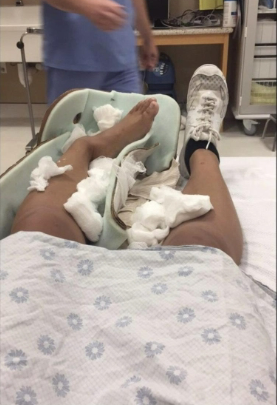
S&S
Extreme pain
Obvious deformity
Swelling and discoloration
Loss of ROM and strength
Treatment
Immediate splinting and referral
Surgical intervention
Crutches and immobilization 4-6 weeks with RTP 4-6 months
Shin Splints
Also called Medial Tibial Stress Syndrome
MOI: occurs as a result of a sudden increase in duration of intensity of training
Location is commonly in the anterior compartment of the lower leg
Can include tibialis anterior strain, microtears in the muscle, microfractures in the tibia or even stress fx
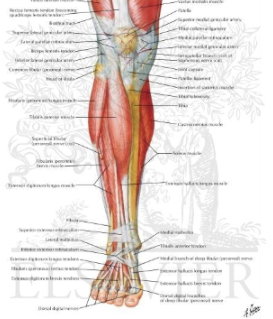
S&S
Pain increasing with running and dorsiflexion
No obvious traumatic mechanism
Treatment
Cold modalities: ice massage, cold whirlpool
Massage
Stretching and strengthening
Compression
Insoles or orthotics
Compartment Syndrome
Anterior muscle compartment is contained within layers of fascial tissue that help maintain position and muscle shape
Compartment Syndrome may occur either through acute trauma or chronic overuse
MOI: increase in fluid pressure within the facial tissue that then compresses the muscles, nerves and blood vessels
The compression causes a loss of oxygen to the muscle which can result in tissue death and serious complication
Chronic is typically found in runners and causes pain and muscle ischemia during activity and then subsides once the activity is ceased.
Many individuals with compartment syndrome complain of foot numbness or tingling during activity caused by increased tissue pressure
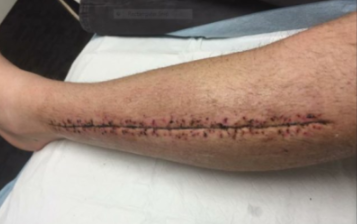
S&S
Pain that increases with activity
Numbness/tingling in foot
Foot drop resulting from neurovascular damage in the lower leg
Pain subsides during rest
May occur bilaterally
Treatment
Refer to physician
Surgical intervention
Cross training
Ankle Sprains
One of the most common injury in athletics
Three ligament structured are associated with the ankle joint
Anterior Talofibular Ligament (ATF) -> Inversion Ankle Sprain
Lateral Ankle Sprain
MOI: when ankle is forcibly moved into inversion and plantarflexion
ATF: first to be injured because it is the weakest of the three ligaments due to its anterior position
S&S
Swelling, discoloration, pain
Joint laxity
Decreased ROM
Decreased ability to WB
Deltoid Ligament -> Eversion Ankle Sprain
MOI: Excessive eversion and dorsiflexion
Medial Ankle Sprain
Occurs in 5% of all ankle sprains
S&S
Pain and discomfort
Decreased ROM
Decreased ability to WB
Swelling and discoloration
Tibiofibular Ligament (TFL)-> High Ankle Sprain
MOI: forced dorsiflexion and rotation of the ankle at the talar dome that causes separation of the tibia and fibula
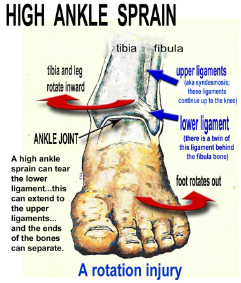
S&S
Pain in high ankle/lower leg
Pain with WB
Slight to no swelling
Decreased ROM
Decreased strength
Treatment for Ankle Sprains
RICE
Immobilization if necessary
Rehab: Ankle pumps, ABCs (ROM is key)
Strengthening Exercises
Proprioception Neuromuscular Control
Cold whirlpool
Horse shoe pad
Achilles Rupture
Most commonly seen in adults older than 30 years who have lost general flexibility or individuals starting new training program after being sedentary for an extended period of time
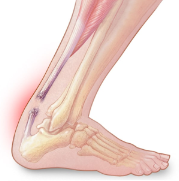
MOI: pushing off or inversion/plantarflexion (ankle sprain)
S&S
Disruption of the structure and rolling of the tendon upward toward the muscle belly
Pain (intense at the onset of the injury)
Treatment
Surgical intervention
1 year long recovery
Common Injuries of the Ankle
Fracture of the Ankle/Lower Leg
Fibula Fracture: most common seen in sport activities
Talus Fracture: least common but can be mistaken as ankle sprains
Tibia Fracture: can be very serious and debilitating due to its status as the primary weight bearing bone
Fractures
MOI: Direct force against bone or indirect abuse such as twisting motion
S&S
High levels of pain
Swelling and discoloration
Obvious deformity
Inability to bear weight
Decrease strength and range of motion
Treatment:
Splint
Immobilize
Non weight bear (NWB)
Surgical interventions
Stress Fractures
Stress fx in the tibia and fibula are significant in their occurrence rates in athletics

S&S
Pain that has developed gradually and increased in severity
Pain likely to be worse after activity rather than during motion
Pain localized to one specific point
Treatment
Bone Scan may be necessary
Remove from sport, NWB or PWB for 4-6 weeks
Cross training regimen
Immobilization
Insoles, new shoes, orthotics to correct biomechanics
Diet
Ankle Dislocation
MOI: twisting motion during full weight bearing, ankle sprain mechanism
The talus will tear the supporting ligaments and often fractures either or both of the malleoli because the talar dome is forcibly removed from its normal position
Sometimes a dislocation can include a tibia/fibula fx

S&S
Extreme pain
Obvious deformity
Swelling and discoloration
Loss of ROM and strength
Treatment
Immediate splinting and referral
Surgical intervention
Crutches and immobilization 4-6 weeks with RTP 4-6 months
Shin Splints
Also called Medial Tibial Stress Syndrome
MOI: occurs as a result of a sudden increase in duration of intensity of training
Location is commonly in the anterior compartment of the lower leg
Can include tibialis anterior strain, microtears in the muscle, microfractures in the tibia or even stress fx

S&S
Pain increasing with running and dorsiflexion
No obvious traumatic mechanism
Treatment
Cold modalities: ice massage, cold whirlpool
Massage
Stretching and strengthening
Compression
Insoles or orthotics
Compartment Syndrome
Anterior muscle compartment is contained within layers of fascial tissue that help maintain position and muscle shape
Compartment Syndrome may occur either through acute trauma or chronic overuse
MOI: increase in fluid pressure within the facial tissue that then compresses the muscles, nerves and blood vessels
The compression causes a loss of oxygen to the muscle which can result in tissue death and serious complication
Chronic is typically found in runners and causes pain and muscle ischemia during activity and then subsides once the activity is ceased.
Many individuals with compartment syndrome complain of foot numbness or tingling during activity caused by increased tissue pressure

S&S
Pain that increases with activity
Numbness/tingling in foot
Foot drop resulting from neurovascular damage in the lower leg
Pain subsides during rest
May occur bilaterally
Treatment
Refer to physician
Surgical intervention
Cross training
Ankle Sprains
One of the most common injury in athletics
Three ligament structured are associated with the ankle joint
Anterior Talofibular Ligament (ATF) -> Inversion Ankle Sprain
Lateral Ankle Sprain
MOI: when ankle is forcibly moved into inversion and plantarflexion
ATF: first to be injured because it is the weakest of the three ligaments due to its anterior position
S&S
Swelling, discoloration, pain
Joint laxity
Decreased ROM
Decreased ability to WB
Deltoid Ligament -> Eversion Ankle Sprain
MOI: Excessive eversion and dorsiflexion
Medial Ankle Sprain
Occurs in 5% of all ankle sprains
S&S
Pain and discomfort
Decreased ROM
Decreased ability to WB
Swelling and discoloration
Tibiofibular Ligament (TFL)-> High Ankle Sprain
MOI: forced dorsiflexion and rotation of the ankle at the talar dome that causes separation of the tibia and fibula

S&S
Pain in high ankle/lower leg
Pain with WB
Slight to no swelling
Decreased ROM
Decreased strength
Treatment for Ankle Sprains
RICE
Immobilization if necessary
Rehab: Ankle pumps, ABCs (ROM is key)
Strengthening Exercises
Proprioception Neuromuscular Control
Cold whirlpool
Horse shoe pad
Achilles Rupture
Most commonly seen in adults older than 30 years who have lost general flexibility or individuals starting new training program after being sedentary for an extended period of time

MOI: pushing off or inversion/plantarflexion (ankle sprain)
S&S
Disruption of the structure and rolling of the tendon upward toward the muscle belly
Pain (intense at the onset of the injury)
Treatment
Surgical intervention
1 year long recovery
 Knowt
Knowt